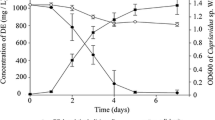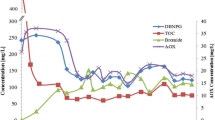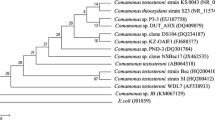Abstract
Halogenated organic compounds constitute one of the largest and most diverse groups of chemicals in the environment. Many of these compounds are toxic, persistent and, as a result of their often limited biodegradability, tend to bioaccumulate in the environment. Dibromoneopentyl glycol (DBNPG) and tribromoneopentyl alcohol (TBNPA) are brominated flame retardants commonly used as additives during the manufacture of plastic polymers and as chemical intermediates in the synthesis of other flame retardants. Both are classified as not readily biodegradable. In this paper, we demonstrate the biodegradation of both DBNPG and TBNPA by a common bacterial consortium under aerobic conditions in enrichment cultures containing yeast extract. DBNPG and TBNPA biodegradation is accompanied by a release of bromide into the medium, due to a biological debromination reaction. Molecular analysis of the clone library PCR amplified 16S rRNA gene was used to characterize the bacterial consortium involved in the biodegradation.





Similar content being viewed by others
References
Aranda C, Godoy F, Becerra J, Barra R, Martínez M (2004) Aerobic secondary utilization of a non-growth and inhibitory substrate 2,4,6-trichlorophenol by Sphingopyxis chilensis S37 and Sphingopyxis-like strain S32. Biodegradation 14:265–274. doi:10.1023/A:1024752605059
Bastos F, Bessa J, Pacheco CC, De Marco P, Castro PML, Silva M, Jorge RF (2002) Enrichment of microbial culture able to degrade 1, 3-dichloro-2-propanol: a comparison between batch and continuous methods. Biodegradation 13:211–220. doi:10.1023/A:1020834603785
Belkin S (1992) Biodegradation of haloalkanes. Biodegradation 3:299–313. doi:10.1007/BF00129090
Ben-Dov E, Shapiro OH, Siboni N, Kushmaro A (2006) Advantage of using Inosine at the 3′ termini of 16S rRNA gene universal primers for the study of microbial diversity. Appl Environ Microbiol 72:6902–6906. doi:10.1128/AEM.00849-06
Bouwer EJ, Zehnder AJB (1993) Bioremediation of organic compound–putting microbial metabolism to work. Bioremediat J 11:360–367
Cámara B, Herrera C, González M, Couve E, Hofer B, Seeger M (2004) From PCBs to highly toxic metabolites by the biphenyl pathway. Environ Microbiol 6:842–850. doi:10.1111/j.1462-2920.2004.00630.x
Díez B, Pedrós-Alió C, Marsh TL, Massana R (2001) Application of denaturing gradient gel electrophoresis (DGGE) to study the diversity of marine picoeukaryotic assemblages and comparison of DGGE with other molecular techniques. Appl Environ Microbiol 67:2942–2951. doi:10.1128/AEM.67.7.2942-2951.2001
Environmental Protection Agency (EPA) (2005) Furniture flame retardancy partnership: environmental profiles of chemical flame-retardant alternatives for low-density polyurethane foam. Chem Hazard Rev 2:2.1–2.26
Erable B, Goubet I, Lamare S, Seltana A, Dominique M, Maugard T (2005) Non conventional hydrolytic dehalogenation of 1-chlorobutane by dehydrated bacteria. Biotechnol Bioeng 91:304–313. doi:10.1002/bit.20437
Ezra S (2005) The fate of brominated neopentyl alcohols in a fractured chalk aquifer. PhD thesis. Ben-Gurion University of the Negev
Ezra S, Feinstein S, Yakirevich A, Adar E, Bilkis I (2006) Retadation of organo-bromides in a fractured chalk aquitard. J Contam Hydrol 86:195–214. doi:10.1016/j.jconhyd.2006.02.016
Felske A, Rheims H, Wolterink A, Stackebrandt E, Akkermans DL (1997) Ribosome analysis reveals prominent activity of an uncultured member of the class Actinobacteria in grassland soil. Microbiology 143:2983–2989
Fetzner S (1998) Bacterial dehalogenation. Appl Microbiol Biotechnol 50:633–657. doi:10.1007/s002530051346
Finan TM, Weidner S, Wong K, Buhrmester J, Chain P, Vorhölter FJ, Hernandez-Lucas I, Becker A, Cowie A, Gouzy J, Golding B, Pühler A (2001) The complete sequence of the 1,683-kb pSymB megaplasmid from the N2-fixing endosymbiont Sinorhizobium meliloti. Proc Natl Acad Sci USA 98:9889–9894. doi:10.1073/pnas.161294698
Gribble GW (2003) The diversity of naturally produced organohalogens. Chemosphere 52:289–297. doi:10.1016/S0045-6535(03)00207-8
Häggblom MM, Bossert ID (2003) Dehalogenation–microbial processes and environmental applications, 1st edn. Kluwer Academic Publishers, Norwell Massachusetts
Jain RK, Kapur M, Labana S, Lal B, Sarma PM, Bhattacharya D, Thakur S (2005) Microbial diversity: application of microorganisms for the biodegradation of xenobiotics. Curr Sci 89:101–112
Janssen BD, Oppentocht JE, Poelarends GJ (2001) Microbial dehalogenation. Curr Opin Biotechnol 12:254–258. doi:10.1016/S0958-1669(00)00208-1
Kumar S, Tomura K, Nei M (2004) MEGA3: integrated software for molecular evolutionary genetics analysis and sequence alignment. Brief Bioinform 5:150–163. doi:10.1093/bib/5.2.150
Lane DJ, Pace B, Olsen GJ, Stahlt DA, Sogint ML, Pace NR (1985) Rapid determination of 16S ribosomal RNA sequences for phylogenetic analyses. Proc Natl Acad Sci USA 82:6955–6959. doi:10.1073/pnas.82.20.6955
Lee MD, Odom JM, Buchanan RJ Jr (1998) Microbial dehalogenation of chlorinated solvents: insight from the field. Annu Rev Microbiol 52:423–452. doi:10.1146/annurev.micro.52.1.423
Olaniran AO, Babalola GO, Okoh AI (2001) Aerobic dehalogenation potentials of four bacterial species isolated from soil and sewage sludge. Chemosphere 45:45–50. doi:10.1016/S0045-6535(01)00075-3
Olaniran AO, Pillay D, Pillay B (2004) Haloalkane and haloacid dehalogenases from aerobic bacterial isolates indigenous to contaminated sites in Africa demonstrate diverse substrate specificities. Chemosphere 55:27–33. doi:10.1016/j.chemosphere.2003.10.067
Organisation for Economic Cooperation and Development (OECD). (1992) OECD guideline for testing of chemicals—Zahn-Wellens/EMPA test (302B)
Ronen Z, Abeliovich A (2000) Anaerobic-aerobic process for microbial degradation of tetrabromobisphenol A. Appl Environ Microbiol 66:2372–2377. doi:10.1128/AEM.66.6.2372-2377.2000
Salkinoja-Salonen M, Uotila J, Jokela ML, Saski E (1995) Organic halogens in the environment: studies of environmental biodegradability and human exposure. Environ Health Perspect 103:63–69. doi:10.2307/3432482
Schenzle A, Lenke H, Spain JCS, Knackmuss HJ (1999) Chemoselective nitro group reduction and reductive dechlorination initiate degradation of 2-chloro-5-nitrophenol by Ralstonia eutropha JMP134. Appl Environ Microbiol 65:2317–2323
Segev O, Abeliovich A, Kushmaro A (2007) Biodegradation of dibromonropentyl glycol by bacterial consortium. Chemosphere 68:958–964. doi:10.1016/j.chemosphere.2007.01.014
Slater JH, Bull AT, Hardman DJ (1995) Microbial dehalogenation. Biodegradation 6:181–189. doi:10.1007/BF00700456
Smidt H, De Vos WM (2004) Anaerobic microbial dehalogenation. Annu Rev Microbiol 58:43–73. doi:10.1146/annurev.micro.58.030603.123600
Song B, Palleroni NJ, Haggblom MM (2000) Isolation and characterization of diverse halobenzoate degrading denitrifying bacteria from soils and sediments. Appl Environ Microbiol 66:3446–3453. doi:10.1128/AEM.66.8.3446-3453.2000
Van Pee KH, Unversucht S (2003) Biological dehalogenation and halogenation reactions. Chemosphere 52:299–312. doi:10.1016/S0045-6535(03)00204-2
Wilkes H, Wittich RM, Timmis KN, Fortnagel P, Francke W (1996) Degradation of chlorinated dibenzofurans and dibenzo-p-dioxins by Sphingomonas sp. strain RW1. Appl Environ Microbiol 62:367–371
Acknowledgments
The work was supported by a grant from BMBF-MOST Cooperation in Water Technologies (Grant WT-501) and a grant from the Ramat Hovav Council, Israel. We thank the Rieger Foundation and the Israel Commercial Industrial club for O. Segev’s generous fellowship.
Author information
Authors and Affiliations
Corresponding author
Rights and permissions
About this article
Cite this article
Segev, O., Meusel, W., Friedenberger, M. et al. Aerobic biodegradation of the brominated flame retardants, dibromoneopentyl glycol and tribromoneopentyl alcohol. Biodegradation 20, 621–627 (2009). https://doi.org/10.1007/s10532-009-9249-z
Received:
Accepted:
Published:
Issue Date:
DOI: https://doi.org/10.1007/s10532-009-9249-z




